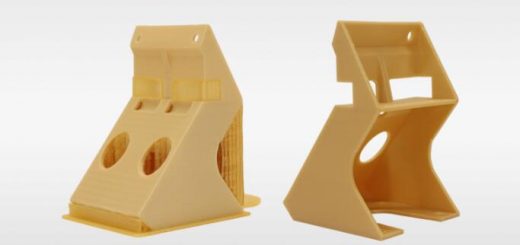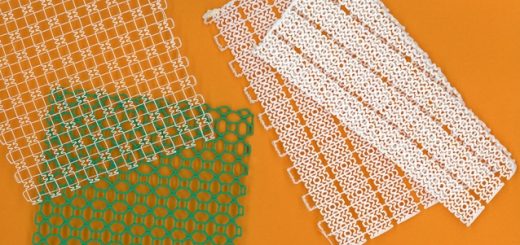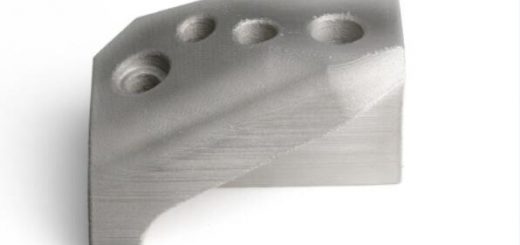3D-Printed Parts Made from Refractory Metals Can Handle the Heat
According to the American Society of Metals and its ASM Metals Reference Book, refractory metals are naturally occurring metallic elements with a melting point above 2,200 degrees C.
Not only are these metals—molybdenum, niobium, tantalum, tungsten, and rhenium—extremely heat- and corrosion-resistant, they retain their structural integrity even at elevated temperatures. This makes them excellent choices for a range of challenging aerospace, industrial, and scientific uses.
 The ability to 3D-print sophisticated double-wall turbine blades from a refractory metal like niobium paves the way for significantly higher engine operating temperatures. Castheon
The ability to 3D-print sophisticated double-wall turbine blades from a refractory metal like niobium paves the way for significantly higher engine operating temperatures. Castheon
One problem is that refractory metals are extraordinarily difficult to process via traditional fabrication methods, such as machining and forming. Between this and their relatively high cost, refractory metals use has long been limited to applications in which workpiece shapes are relatively simple, material removal is minimal, and easier-to-manufacture superalloys wouldn’t perform as needed.
Thanks to additive manufacturing (AM) and the efforts of researchers like Youping Gao, however, that’s all about to change.
![]() Faster Flights
Faster Flights
Gao is the president of Castheon Inc., an AM research, development, and production company based in Thousand Oaks, Calif. He explained that laser powder bed fusion (LPBF) resolves most of the manufacturability problems associated with refractory metals and alloys. And as with all metal AM technologies, it also allows for the creation of topologically optimized, lightweight components incorporating porous or lattice structures that would otherwise be impractical or even impossible to produce.
Cost-effective manufacturing of metal components with melting points nearly twice that of INCONEL, Hastelloy, and other popular heat-resistant superalloys (HRSAs) opens the door to some exciting possibilities. Higher temperatures mean more fuel-efficient and longer-lasting gas turbine engines, which are of chief importance to the commercial airline and power-generation industries.
But there’s also the potential for hypersonic air travel, one of the many projects that Gao and his team have been working on since founding the company in 2016.
“NASA, the U.S. Air Force, and other agencies have long been interested in sustained hypersonic flight for commercial and military uses,” said Gao. “Until fairly recently, however, it wasn’t possible to fabricate refractory metals into the sophisticated shapes needed to support speeds of Mach 5 and above.”
He and his colleagues have found that metal AM not only can produce these shapes, but niobium-based alloys are far more stable than their wrought equivalents. They exhibit tensile strength 1.8 times greater at temperatures of 1,300 degrees C. Other refractory metals, like tungsten and rhenium, also exhibit similar benefits, he said.
![]() Tough to Make
Tough to Make
Gao encountered challenges on his way to finding success in this niche market. He called the production of refractory metal alloys and powders a “nightmare,” leading to high costs and material scarcity. And 3D printing them is also quite challenging because of a narrow operating window and a “unique grain control mechanism,” he said.
 This tantalum nozzle segment was made for a U.K. Space Agency project. H.C. Starck
This tantalum nozzle segment was made for a U.K. Space Agency project. H.C. Starck
![]() jet engine
jet engine
This tantalum nozzle segment was made for a U.K. Space Agency project. H.C. Starck
Regardless, these unique metals are vastly superior to their HRSA alternatives, and Gao is confident that their use will increase as raw material prices come down and more people acquire the knowledge needed to print them.
Faith Oehlerking agrees with each of these points. An additive manufacturing R&D engineer at refractory metals manufacturer and parts-maker H.C. Starck Solutions, Coldwater, Mich., she spends her days unlocking the mysteries of 3D printing tungsten, tantalum, and other elements. Like Gao, Oehlerking and the H.C. Starck team use Renishaw’s LPBF technology to help her do that. Starck also builds refractory metal parts and test coupons on a binder-jet 3D printer provided through a collaborative arrangement with ExOne.
Some of the challenges molybdenum, tungsten, tantalum, and niobium present come from their body-centered cubic atomic structure. They have a ductile-to-brittle transition temperature (DBTT), Oehlerking explained. Metals like molybdenum and tungsten have very high DBTTs, which can lead to stress build-up and microcracking in the finished component.
With wrought materials, it’s possible to mitigate these failure modes through thermomechanical processes such as cold working, but this is impractical with 3D-printed components. The solution is to alloy the base refractory metals with elements like rhenium, nickel, and iron in order to lower the DBTT of the metal and reduce stress.
“We’re conducting a great deal of research in this area but are also evaluating different print strategies and technologies,” said Oehlerking. “For example, heating the build plate is a common strategy to reduce cracking, with some machines able to reach 500 degrees C or higher. This has the potential to ease the transition from liquid to solid, especially on molybdenum and tungsten, which have a much higher DBTT.”
It’s also important to note that oxygen in the build chamber or powder is detrimental, as too much oxygen can further increase the DBTT and microcracking of the metal, Oehlerking said. “Having high-quality feedstock and good atmosphere control in your metal AM machine is imperative to the success of printing refractory metals.”
Even when it’s impossible to eliminate microcracking and its resulting loss of structural integrity, however, refractory metals still have an important role to play.
Tungsten, for instance, is widely used for the Anti-Scatter Grid Collimators found in X-ray and CT scanners, which do not see the same level of mechanical loading as those found in aerospace and military applications. Refractory metals also exhibit excellent thermal conductivity and a low coefficient of thermal expansion, making them well-suited for heat exchangers and the crucibles used to grow sapphires.
![]() STAR-Bound
STAR-Bound
One project Starck’s involved in that does require the superior structural integrity possible with most refractory metals is to print a resistojet nozzle segment for the UK Space Agency. The project is called Super high Temperature Additively manufactured Resistojets, or STAR. (A resistojet is a simple electric propulsion system that develops thrust by heating a fluid.—Ed.)
Because of its low DBTT and high-temperature resistance, tantalum and a tantalum-tungsten alloy (Ta10W) were selected for the satellite component, which is required to exhibit consistent electrical conductivity, extreme tensile strength, and minimal distortion at temperatures exceeding 3,000 degrees C.
![]() refractory metal
refractory metal
This thruster for a reaction-control system was 3D-printed from a niobium alloy. Castheon
Using 3D printing partner HiETA Technologies’ Renishaw AM400 LPBF printer, various build parameters were tested in order to achieve 99.95% dense coupons from both materials. Those settings were then applied to produce prototypes of the thin-walled nozzle segments. As of this writing, these parts are being evaluated internally by H.C. Starck Solutions and at England’s University of Southampton.
Metal AM brings incredible flexibility to refractory metals development projects like this, as does the ability to create custom alloy blends. Unlike most manufacturers, which must mix different metal powders together to achieve the desired properties, Starck can atomize its own metal powders.
According to Oehlerking, these “pre-alloyed” metals provide better consistency when 3D printing. “We have a bunch of different metals available and are always developing more,” she said. “For instance, there’s titanium-zirconium-molybdenum, which is a popular medical alloy. But there’s also molybdenum-lanthanum, tungsten-rhenium, and the niobium-based alloy C-103, which Youping Gao uses for a lot of his work.
“Between the refractory metals and 3D printing, the potential here is enormous, especially in the aerospace and defense sectors. We’re really just getting started,” said Oehlerking.
Source: The Additive Report
For press release, welcome to send to 3D Science Valley at 2509957133@qq.com




Recent Comments